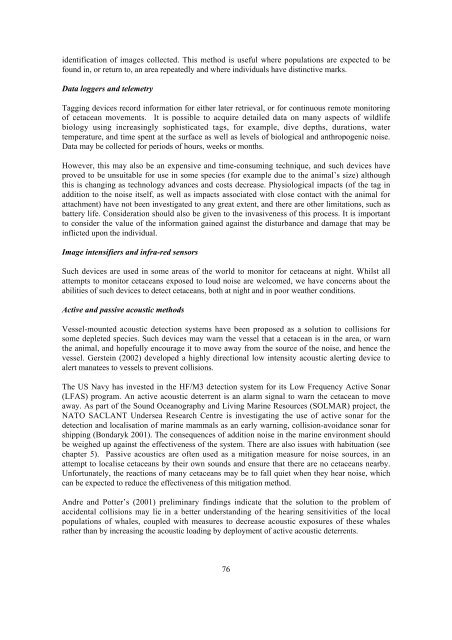Oceans of noise - Whale and Dolphin Conservation Society
Oceans of noise - Whale and Dolphin Conservation Society
Oceans of noise - Whale and Dolphin Conservation Society
Create successful ePaper yourself
Turn your PDF publications into a flip-book with our unique Google optimized e-Paper software.
identification <strong>of</strong> images collected. This method is useful where populations are expected to be<br />
found in, or return to, an area repeatedly <strong>and</strong> where individuals have distinctive marks.<br />
Data loggers <strong>and</strong> telemetry<br />
Tagging devices record information for either later retrieval, or for continuous remote monitoring<br />
<strong>of</strong> cetacean movements. It is possible to acquire detailed data on many aspects <strong>of</strong> wildlife<br />
biology using increasingly sophisticated tags, for example, dive depths, durations, water<br />
temperature, <strong>and</strong> time spent at the surface as well as levels <strong>of</strong> biological <strong>and</strong> anthropogenic <strong>noise</strong>.<br />
Data may be collected for periods <strong>of</strong> hours, weeks or months.<br />
However, this may also be an expensive <strong>and</strong> time-consuming technique, <strong>and</strong> such devices have<br />
proved to be unsuitable for use in some species (for example due to the animal’s size) although<br />
this is changing as technology advances <strong>and</strong> costs decrease. Physiological impacts (<strong>of</strong> the tag in<br />
addition to the <strong>noise</strong> itself, as well as impacts associated with close contact with the animal for<br />
attachment) have not been investigated to any great extent, <strong>and</strong> there are other limitations, such as<br />
battery life. Consideration should also be given to the invasiveness <strong>of</strong> this process. It is important<br />
to consider the value <strong>of</strong> the information gained against the disturbance <strong>and</strong> damage that may be<br />
inflicted upon the individual.<br />
Image intensifiers <strong>and</strong> infra-red sensors<br />
Such devices are used in some areas <strong>of</strong> the world to monitor for cetaceans at night. Whilst all<br />
attempts to monitor cetaceans exposed to loud <strong>noise</strong> are welcomed, we have concerns about the<br />
abilities <strong>of</strong> such devices to detect cetaceans, both at night <strong>and</strong> in poor weather conditions.<br />
Active <strong>and</strong> passive acoustic methods<br />
Vessel-mounted acoustic detection systems have been proposed as a solution to collisions for<br />
some depleted species. Such devices may warn the vessel that a cetacean is in the area, or warn<br />
the animal, <strong>and</strong> hopefully encourage it to move away from the source <strong>of</strong> the <strong>noise</strong>, <strong>and</strong> hence the<br />
vessel. Gerstein (2002) developed a highly directional low intensity acoustic alerting device to<br />
alert manatees to vessels to prevent collisions.<br />
The US Navy has invested in the HF/M3 detection system for its Low Frequency Active Sonar<br />
(LFAS) program. An active acoustic deterrent is an alarm signal to warn the cetacean to move<br />
away. As part <strong>of</strong> the Sound Oceanography <strong>and</strong> Living Marine Resources (SOLMAR) project, the<br />
NATO SACLANT Undersea Research Centre is investigating the use <strong>of</strong> active sonar for the<br />
detection <strong>and</strong> localisation <strong>of</strong> marine mammals as an early warning, collision-avoidance sonar for<br />
shipping (Bondaryk 2001). The consequences <strong>of</strong> addition <strong>noise</strong> in the marine environment should<br />
be weighed up against the effectiveness <strong>of</strong> the system. There are also issues with habituation (see<br />
chapter 5). Passive acoustics are <strong>of</strong>ten used as a mitigation measure for <strong>noise</strong> sources, in an<br />
attempt to localise cetaceans by their own sounds <strong>and</strong> ensure that there are no cetaceans nearby.<br />
Unfortunately, the reactions <strong>of</strong> many cetaceans may be to fall quiet when they hear <strong>noise</strong>, which<br />
can be expected to reduce the effectiveness <strong>of</strong> this mitigation method.<br />
Andre <strong>and</strong> Potter’s (2001) preliminary findings indicate that the solution to the problem <strong>of</strong><br />
accidental collisions may lie in a better underst<strong>and</strong>ing <strong>of</strong> the hearing sensitivities <strong>of</strong> the local<br />
populations <strong>of</strong> whales, coupled with measures to decrease acoustic exposures <strong>of</strong> these whales<br />
rather than by increasing the acoustic loading by deployment <strong>of</strong> active acoustic deterrents.<br />
76

















